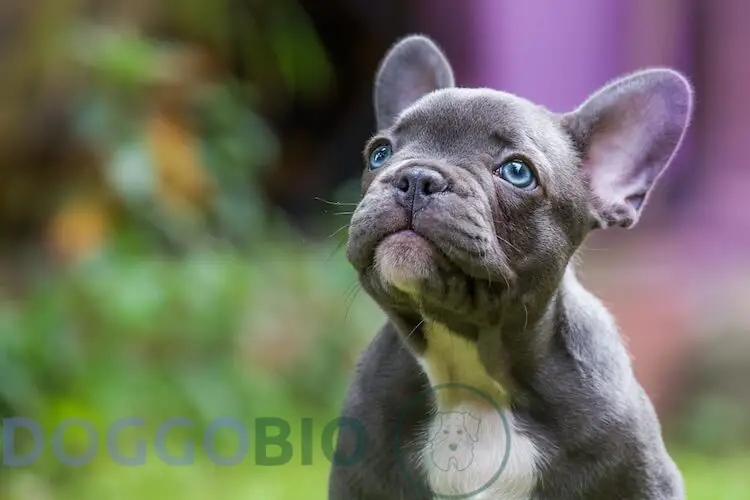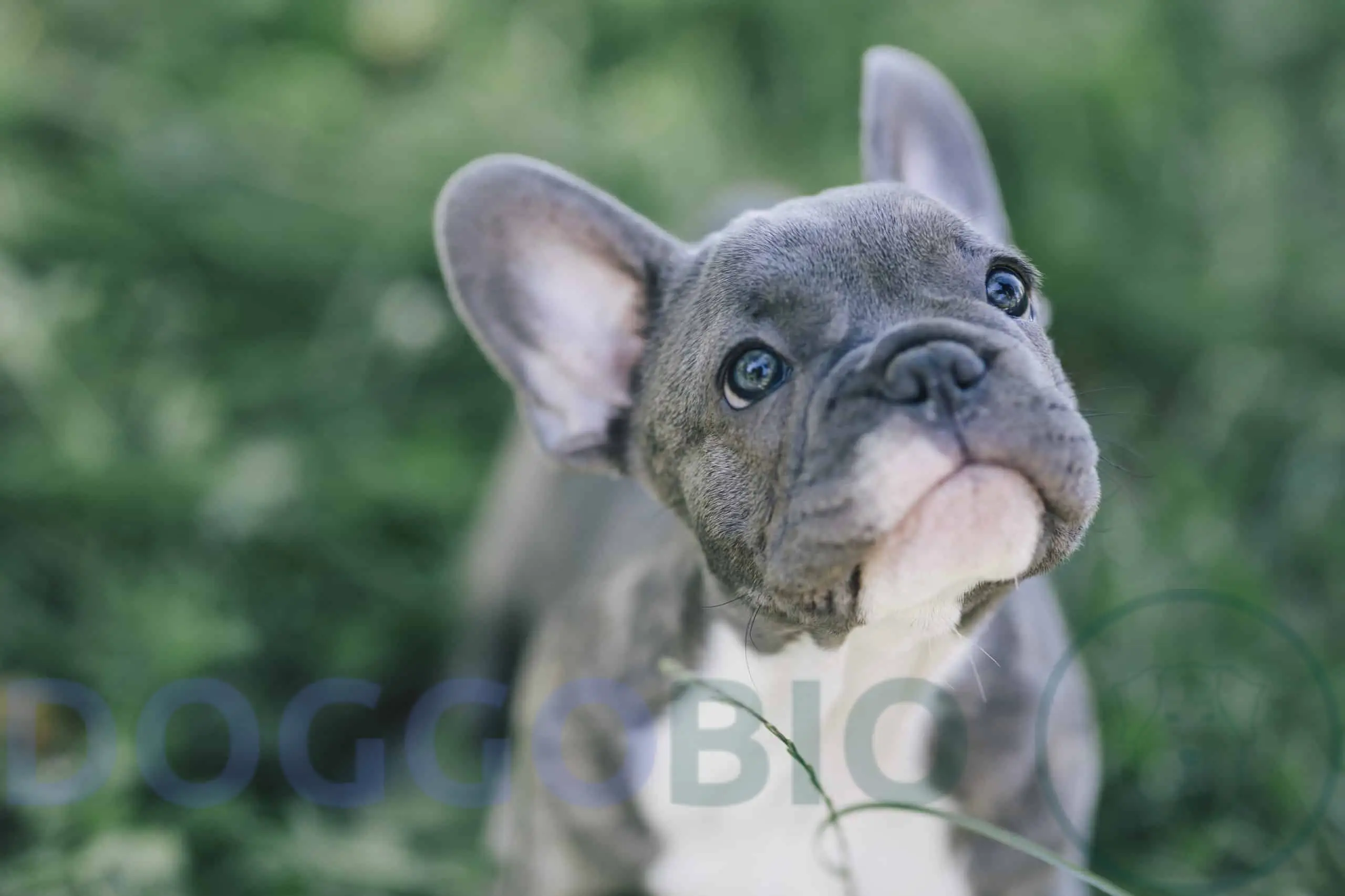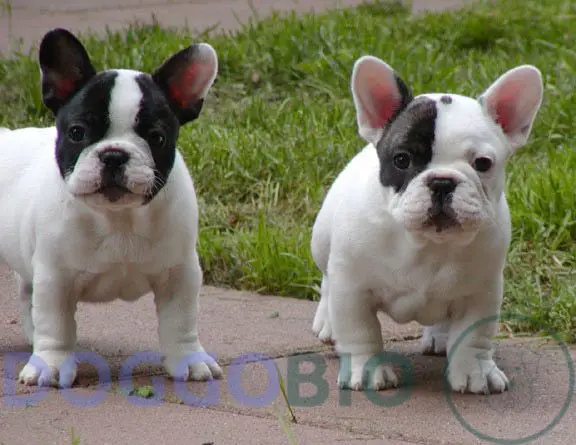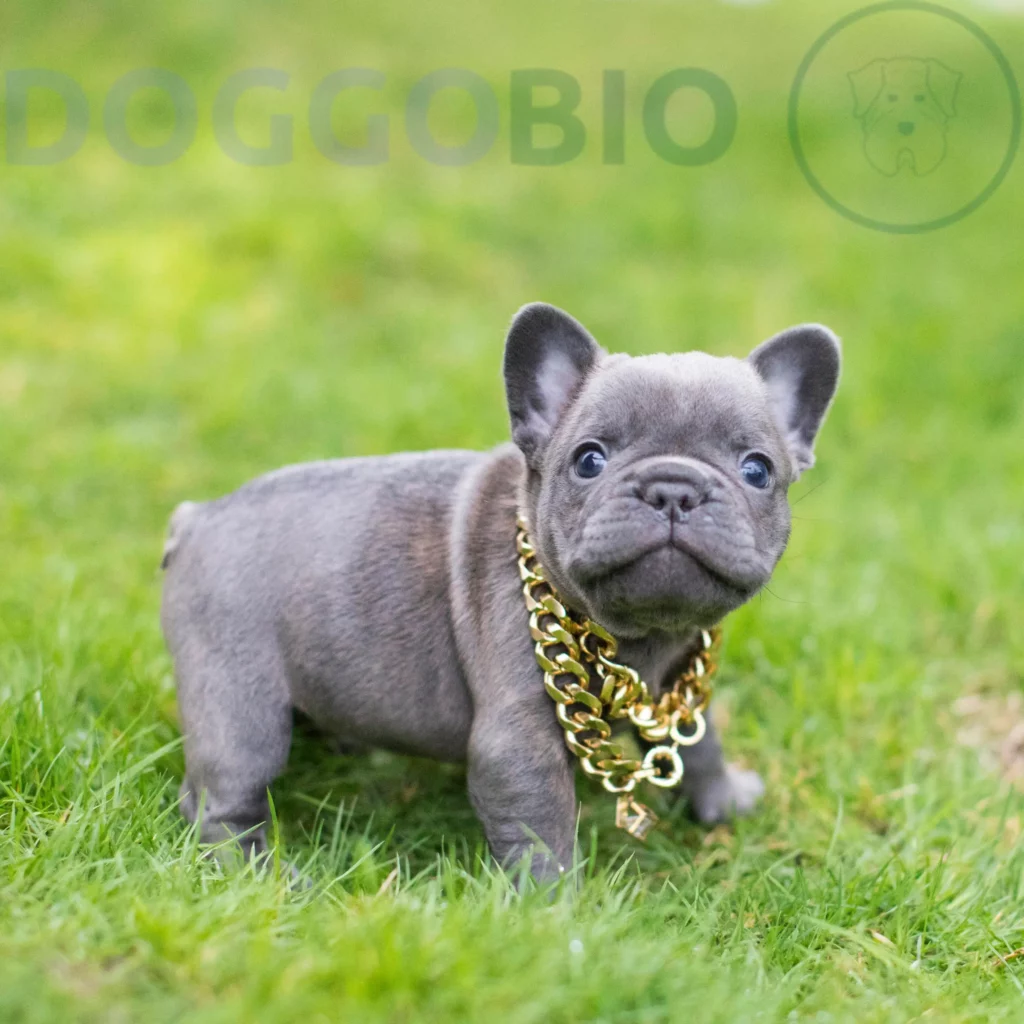Welcome to the enchanting world of the Blue Eyed French Bulldog, where elegance and charm converge in a captivating canine companion. With their mesmerizing azure gaze, these delightful creatures are a testament to the breed’s unique allure. As a particular variant of the French Bulldog, their distinctive blue eyes set them apart and instantly captivate the hearts of all who encounter them.
Join us on a journey to discover the enchanting qualities and irresistible charm of the Blue Eyed French Bulldog. This breed embodies the perfect balance of grace, companionship, and undeniable beauty.
A Brief Overview of Blue Eyed French Bulldog
| Other Names | Blue Eyes Frenchie |
| Size | Small |
| Weight | 20 – 28 pounds |
| Height | 11 – 12 inches |
| Colors | Gray, Black, Blue, Cream, White, Fawn |
| Lifespan | 11 – 14 years |
| Puppy Costs | $4,500 upwards |
Why do French Bulldogs have Blue Eyes?
Why do French Bulldogs possess those captivating blue eyes when the norm for most dogs is luscious shades of brown? The answer lies in a fascinating interplay of genetics, pigmentation, and health factors.
Primarily, the intricate workings of genetics grant the French Bulldog its distinctive blue gaze. In cases where blue eyes have been prevalent in a Frenchie’s lineage, the likelihood of inheriting this striking trait increases.

1. Merle Genes
Merle gene (M-locus) is the elusive element that holds sway over the enchanting blue eyed French Bulldogs.
When this gene manifests in a Frenchie, the likelihood of those mesmerizing blue orbs becomes all the more apparent. Intriguingly, the merle gene orchestrates a captivating dance of pigment dilution, gracefully lightening the nose, eyes, and fur.
However, it’s important to note that merely carrying this gene does not always ensure the manifestation of those captivating blue eyes in Frenchies or any canine companion.
2. ALX4 Genes
Prepare to be amazed by the discoveries of a groundbreaking study conducted by Embark Veterinary, a titan among dog DNA testing companies.
A remarkable finding emerged through an analysis of a staggering 6,000 dogs’ comprehensive genetic profiles—a genetic mutation residing near the esteemed ALX4 gene emerged as a powerful influencer in bestowing dogs with those captivating blue eyes.
3. Melanin Levels
One pivotal player in this grand symphony of hues is melanin—the great pigment within the iris. As if following a cryptic code, melanin levels hold the key to unveiling the eye color mysteries of our canine companions. Dogs blessed with abundant melanin enjoy the warmth of rich, velvety brown eyes.
Conversely, as the concentration of this captivating pigment diminishes, the stage is set for lighter and more ethereal eye colors to emerge, painting a beautiful portrait that leaves us in awe.
Are Blue Eyed French Bulldogs Truly Blue?
Contrary to popular belief, the blue eyes seen in French Bulldogs (and other blue-eyed dogs) are not truly blue, as revealed by Geneticist Kristopher Irizarry from the College of Veterinary Medicine at Western University of Health Sciences.
In reality, dogs with blue eyes have irises that lack pigmentation, rendering them colorless. Like water and the sky appear blue due to light scattering, the same phenomenon occurs in blue-eyed dogs. When light enters their eyes, it scatters back into the atmosphere, creating the illusion of a blue hue.
The mutation of the ALX4 gene in dogs with blue eyes leads to reduced pigment production in the eyes, resulting in their blue-like appearance. It’s important to note that these eyes lack pigmentation and lack proper blue coloration.
Will My French Bulldog Puppy Have Blue Eyes Forever?
No. Puppies are born with blue eyes, but their eye color changes as they grow.
In most cases, French Bulldogs end up with dark brown eyes. This change usually occurs around 9 to 12 weeks of age, although it can happen as late as 16 weeks.
Eye colors range from light brown to dark brown, amber, or even rare permanent blue.
History of French Bulldog
The French Bulldog breed has a rich history that dates back to the 1850s in England.
As industrial workers migrated to France during the Industrial Revolution, they brought their miniature bulldogs, eventually known as French Bulldogs.
Early French Bulldogs differed from the modern breed we see today. As their popularity grew in France, breeders crossed them with terriers and pugs, resulting in the breed’s distinctive bat ears, now a hallmark.
Although the origin of the “bat ears” can be traced back to England, the French played a significant role in developing the breed into what it is today. The French were so fond of these dogs that they named them “Bouledogues Français.”
The breed gained popularity over time and was officially recognized by the American Kennel Club (AKC) in 1898. By 1940, only a hundred French Bulldogs were registered with the AKC, but they had already established themselves as one of the top ten breeds in countries like Great Britain, Australia, and the United States.
What Does a Blue Eyed French Bulldog Look Like?
Frenchie with Blue Eyes exhibits the typical physical characteristics most French Bulldogs share.
- They possess a compact and robust build characterized by a solid bone structure and well-developed muscles.
- Their head is prominent, square-shaped, and has a deep, set-back muzzle.
- The eyes of a Frenchie with Blue Eyes are round, while their ears are distinctively bat-shaped.
- Their tail is naturally short, with variations ranging from a straight tail to a slightly curled or screwed appearance.
Size, height, and weight
| Height | Weight | |
| Male | 11 – 13 inches | 20 – 28 pounds |
| Female | 11 – 13 inches | 17 – 24 pounds |
Coat colors and types
The coat color of a French Bulldog can indeed be associated with the presence of blue eyes. If you’re curious about this correlation, the answer is affirmative.
As mentioned earlier, the Piebald gene creates patterns of unpigmented spots or black-and-white patches on a dog’s coat. This same lack of pigmentation is also associated with the occurrence of blue eyes in dogs, as we previously explained.
Among the various coat colors, you can find blue eyed French Bulldogs in the following variations:
- White
- Black
- Grey
- Fawn
- Blue
These distinctive coat and eye color combinations contribute to these adorable canines’ unique and captivating appearances.
Eye colors and types
The AKC’s breed standard for French Bulldogs outlines specific guidelines for the appearance of their eyes.
By these standards, Frenchies are expected to have round-shaped eyes of moderate size without appearing sunken or bulging. Ideally, the eyes should be set wide apart and positioned low in the skull, as far away from the ears as possible.
These characteristics contribute to the unique and charming expression that defines the classic look of French Bulldog eyes.
1. Brown-eyed French Bulldog

The most commonly observed eye color in French Bulldogs is brown. Brown-eyed Frenchies owe their eye color to the presence of high levels of melanin and the absence of the
gene.
The shades of brown can vary, ranging from deep and dark brown to a lighter hazel hue that may even appear slightly greenish.
2. Blue-eyed French Bulldog

Blue eyes are not a characteristic feature commonly associated with French Bulldogs, but they can occasionally be found in specific individuals. The intensity of blue eye color can vary, with some Frenchies exhibiting deeper shades of blue while others may have lighter tones.
Blue eyes in French Bulldogs can often be attributed to the M-locus and S-locus genes. These genetic factors contribute to the mesmerizing blue hues observed in some French Bulldogs, adding a unique touch to their overall appearance.
3. Black-eyed French Bulldog

Black-eyed French Bulldogs conform to the preferred eye coloration outlined by the AKC breed standard. Their eyes display a rich, deep hue, often approaching a brown-black shade.
This stunning color results from elevated melanin levels in the iris, giving these adorable canines a distinct and striking appearance.
Temperament and Personality
According to the American Kennel Club, French Bulldogs are known for being playful, alert, adaptable, and intelligent. They possess an even-tempered disposition overall but do require attention and companionship.
Frenchies are not excessive barkers, but they may vocalize when they feel excited or have a reason to alert their owners. Another distinct characteristic of the breed is their tendency to snort, adding to their unique charm.
These dogs are highly aware of their surroundings and maintain an alertness that makes them excellent watchdogs. While they are affectionate, French Bulldogs are generally not overly boisterous. They make great companions and are known for their comfort-seeking behavior, enjoying proximity to their loved ones.
Is a blue eyed French Bulldog a good fit for families?
Indeed, Frenchie Blue Eyes make excellent family pets. They have a friendly and non-aggressive nature, which makes them great companions for children.
Additionally, they tend to get along well with other pets in the household, further adding to their suitability as family pets.
Training

Training a Blue Eyed French Bulldog can be a delightful yet slightly challenging endeavor. These furry companions are known for their strong will and independent nature, which adds an extra layer of excitement to the training process.
To ensure success, it’s crucial to keep training sessions short, engaging, and enjoyable. By incorporating positive reinforcements such as treats, praise, and playtime, you can keep your Blue Eyed French Bulldog motivated and eager to learn.
Remember to be patient and consistent in your training efforts, and soon, you’ll witness the fruits of your labor as your furry friend blossoms into a well-behaved and obedient companion.
Exercise Requirements
Regarding exercise, it’s essential to approach it cautiously for a French Bulldog with Blue Eyes. As a brachycephalic breed, they are more susceptible to heatstroke and breathing difficulties, so it’s crucial to prioritize their well-being during physical activity.
A moderate amount of exercise, such as around 45 minutes of walking, is generally suitable for them. However, monitoring their breathing and energy levels is essential to prevent overheating or exhaustion.
Grooming and Cleaning
Grooming a Blue Eyed French Bulldog is straightforward due to its short coat.
- Regular brushing helps control shedding, especially during the spring and fall seasons.
- Bathing once a month with a gentle, organic dog shampoo is recommended. Clean their wrinkled face with deodorizing dog wipes.
- Dental hygiene is essential, so brush their teeth 2-3 times a week with enzymatic dog toothpaste.
- Check their ears weekly to prevent infections.
| Grooming Needs | Grooming Frequency |
| Brushing | 2 – 3 weekly |
| Bathing | Once a month |
| Teeth Brushing | 2 – 3 weekly |
| Ear Cleaning | Check weekly |
| Nail Trimming | As needed |
Are French Bulldogs hypoallergenic?
No, French Bulldogs with blue eyes, like their counterparts, are not hypoallergenic.
These adorable canines are moderate shedders, which means they can produce allergens that may trigger allergies in sensitive individuals.
Common Health Issues
While visually captivating, French Bulldogs with blue eyes have a higher likelihood of experiencing specific health issues.
Here are seven common health issues to be aware of:

1. Deafness
Blue eyed French Bulldogs can be more prone to deafness due to specific genes like Merle and Piebald.
The Merle gene is associated with congenital deafness, while the Piebald gene affects melanin production in the inner ear.
Breeder Karen Dibert advises that all-white or all-black Frenchies without brindle markings may carry the deaf gene and could produce blue-eyed dogs with eye issues.
A BAER test can diagnose hearing loss in puppies. If your Frenchie is deaf, use specialized collars and ID tags for communication and safety.
2. Blindness
Blue eyes in French Bulldogs may signal potential vision concerns, often associated with the dominant merle genes. However, it’s important to note that having blue eyes doesn’t guarantee blindness.
If both parents carry and pass on the Merle gene, there’s an increased risk of eye defects, potentially leading to blindness in their offspring. Nonetheless, not all blue eyed French Bulldogs will encounter vision issues.
Regular vet check-ups and vigilant monitoring are crucial for maintaining your Frenchie’s overall eye health.
3. Anterior uveitis
Anterior uveitis is a distressing condition characterized by inflammation within the eye.
If your dog is experiencing this condition, you may notice signs such as squinting, scratching, redness, discharge, or a cloudy change in eye color.
While it can be treated, there are infrequent instances where surgical removal of the affected eye may be necessary.
4. Cataracts
Cataracts can develop in dogs due to various factors such as diabetes, eye injury, pests, or diet. They can be hereditary, have a sudden onset, or gradually progress over time.
One noticeable sign is a change in eye color, which may appear blue and cloudy. If left untreated, cataracts can eventually lead to blindness.
It’s essential to seek treatment to address this condition and prevent vision loss.
5. Corneal dystrophy
Corneal dystrophy is an inherited eye disease that typically doesn’t cause pain but can impact your dog’s vision. One of the noticeable signs is a change in eye color, often appearing as a cloudy blue hue.
Treatment for corneal dystrophy varies depending on the specific type diagnosed, so your dog must be appropriately diagnosed to determine the most appropriate course of action. Working closely with a veterinarian will help manage this condition and maintain your dog’s eye health.
6. Glaucoma
Glaucoma in French Bulldogs results from improper drainage of eye fluid, leading to increased pressure and, in severe cases, possible blindness. Watch out for signs like a noticeable change in eye color, often appearing cloudy or blue. Early detection is vital.
Glaucoma treatment focuses on lowering intraocular pressure, which can involve medications, surgeries, or, in extreme situations, removal of the affected eye. Consult your veterinarian to determine the best course for managing glaucoma and safeguarding your Frenchie’s eye health.
7. Nuclear sclerosis
Nuclear sclerosis is a common age-related condition in dogs, often seen around six years old. While not painful, it can alter their vision, causing a cloudy blue tint in the eyes.
Treatment for nuclear sclerosis may not be necessary, as it typically doesn’t significantly affect a dog’s quality of life. Regular vet check-ups can help track the condition’s progression and ensure your furry companion receives appropriate care.
How Long Does French Bulldog with Blue Eyes Live?
The average lifespan of French Bulldogs with blue eyes is typically around 10 to 12 years.
How Much is The Price of Frenchie with Blue Eyes?
The price of a Blue Eyed French Bulldog can be higher compared to non-blue-eyed French Bulldog. This is due to the breeding process, which often involves artificial insemination and C-sections.
Specifically, Grey French Bulldogs with Blue Eyes tend to have a higher price range, typically adding $1,000 to $2,000. The price can also vary based on the coat color.
| Coat Color | Estimated Price |
| Grey French Bulldog with Blue Eyes price | $4,500 |
| Merle French Bulldog with Blue Eyes price | $7,500 |
| White French Bulldog with Blue Eyes price | $6,500 |
| Black French Bulldog with Blue Eyes price | $5,500 |
| Blue French Bulldog with Blue Eyes price | $7,500 |
Is Blue Eyed French Bulldog Right For Me?
French Bulldogs make great pets for families or individuals seeking a lapdog companion. They are adaptable, get along well with other pets, and are generally easy to train.
However, as a flat-faced breed, they may have breathing difficulties and require extra care. If you’re considering a Frenchie with blue eyes, do thorough research and find a reputable breeder who prioritizes the dog’s health.
Some Posts You Wanna Read More
- Chocolate French Bulldog
- Blue American Bulldog
- Black English Bulldog
- How Long Do Bulldogs Live?
- Do English Bulldogs Have Tails?
- American Bulldog Johnson
- Mini French Bulldog
- Fluffy French Bulldog
- Grey French Bulldog
Frequently Asked Questions
Why Does My French Bulldog Have Red Eyes?
If you notice that your French Bulldog’s eyes appear red, it is essential to pay attention as it could indicate an underlying health issue. There are several possible reasons for red eyes in a Frenchie, including:
- Cherry eye: This is a condition where the third eyelid gland becomes swollen and protruding, leading to a red mass in the corner of the eye.
- Corneal ulcers: These are open sores on the surface of the cornea, which can cause redness, discharge, and discomfort.
- Dry eye: Also known as keratoconjunctivitis sicca, it occurs when the eyes do not produce enough tears, resulting in dryness, redness, and irritation.
- Eye injury: Trauma or damage to the eye can cause redness, swelling, and pain.
- Dust or foreign objects: If there is dust, debris, or a foreign object in the eye, it can cause redness and irritation.
If you have concerns about your Frenchie’s red eyes, it is advisable to seek veterinary attention. They can provide a comprehensive evaluation, diagnose the underlying cause, and recommend appropriate treatment.
What color is the rarest Frenchie?
Regarding French Bulldogs, the rarest color you can find is Blue Merle. These unique and captivating dogs have a beautiful coat pattern, distinguishing them from other Frenchies.
Combining blue and merle markings creates a stunning and distinct appearance that is highly sought after by enthusiasts and collectors.
If you’re lucky to come across a Blue Merle French Bulldog, you’ve encountered one of this beloved breed’s most elusive and rare color variations.
Is the Blue-Eyed Gene more common in male or female Frenchies?
No, the Blue-Eyed Gene is not more common in either male or female Frenchies. The Merle gene primarily determines the presence of blue eyes in French Bulldogs, and there is no significant gender-based difference in the occurrence of blue eyes. The percentage of French Bulldogs with the blue-eyed gene is similar for both males and females.
Are French Bulldogs Color Blind?
No, French Bulldogs are not color blind, but their color vision differs from that of humans. French Bulldogs, like most dog breeds, have two types of color cone cells in their retinas, allowing them to perceive specific colors. They can see shades of blue and yellow and various shades of gray.
However, their color vision is limited compared to humans, who have three types of color cone cells (red, blue, and yellow) in their retinas, enabling them to perceive a broader spectrum of colors. So, while French Bulldogs can distinguish between some colors, their color vision is less extensive than that of humans.
Is Blue-Eyed Different From Brown-Eyed French Bulldogs?
Yes, Blue Eyed French Bulldogs have different eye colors than Brown-Eyed.
Blue eyed French Bulldogs have blue-colored eyes, while Brown-Eyed French Bulldogs have brown-colored eyes.
In terms of their overall appearance, French Bulldogs are known for their distinctive compact and muscular form, resembling their larger Bulldog counterparts. They have an active and intelligent disposition and are characterized by their sleek coat and medium to small-sized physique.
Blue-eyed and Brown-Eyed French Bulldogs’ primary difference is their eye color.
Is AKC recognized as a blue eyed French Bulldog?
No, French Bulldogs with blue or green eyes are not recognized by the American Kennel Club (AKC). The AKC breed standard for French Bulldogs specifies that eye color should be dark or black. Blue or green eyes are considered non-standard and do not meet the requirements set by the AKC.
Conclusion
In conclusion, the Blue Eyed French Bulldog is a breed that leaves an indelible impression on anyone fortunate to cross paths with them. Their striking blue eyes add to their physical splendor and are windows into their soulful and affectionate nature. These endearing canines combine elegance with a delightful and amiable temperament, making them cherished companions and beloved family members.
Whether it’s their unique eye color, playful spirit, or unwavering loyalty, the Blue Eyed French Bulldog continues to captivate hearts and bring joy to those fortunate enough to call them their own. Embodying a harmonious blend of charm, beauty, and companionship, the Blue Eyed French Bulldog is a remarkable and unforgettable breed.

Pingback: Fluffy French Bulldog: A Powerful Elixir of Love & Laughter 2023
Pingback: How Long Do French Bulldogs Live? Nurturing a Lifetime 2023
Pingback: Mini French Bulldogs: Unleash Your Heart's Love for Petite 2023